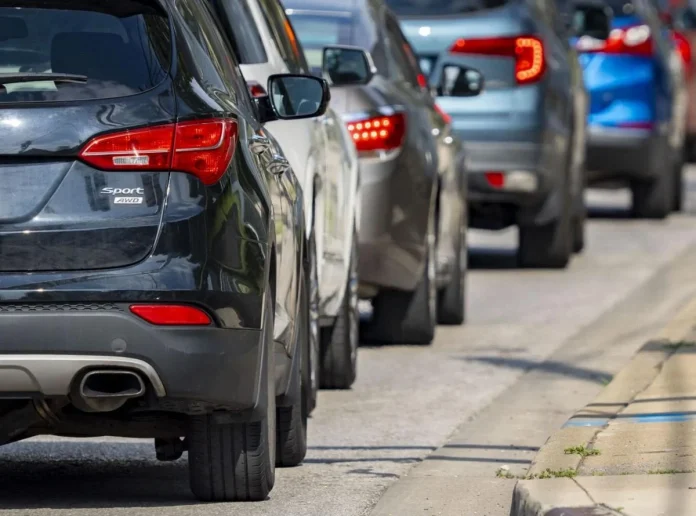Indianapolis could see hotter days and more rainfall if the head of the Environmental Protection Agency gets his way.
Earlier this summer, the EPA’s leader, Lee Zeldin, chose Indianapolis to announce plans to roll back regulations for greenhouse gas emissions.
But one former deputy administrator for the agency sees a major problem: In a state like Indiana, which already has limited environmental regulations, the EPA sets the standard.
“So, if the federal standards no longer control greenhouse gas emissions, there will be no greenhouse gas emissions requirements here,” Janet McCabe told Mirror Indy.
Zeldin wants to undo a ruling from 2009 that serves as the basis for rules limiting greenhouse gases from vehicles, power plants, the oil and gas industry and other sectors.
McCabe, who served as deputy administrator for the EPA from 2021 to 2024 under the Biden administration, said it’s important that Hoosiers have what she calls the “federal minimum.”
She spoke to Mirror Indy about what Zeldin’s plan would mean for Indianapolis.
Why does it matter what the EPA does?
If the EPA doesn’t regulate greenhouse gas emissions, chances are Indiana won’t either.
According to McCabe, EPA standards are designed to be the baseline level of protection for health and the environment. Environmental laws, like the Clean Air Act and Clean Water Act, were written so states have the ability to pass more protective rules and laws.
But some states, like Indiana, have made it more difficult for that to happen, so federal rules end up becoming the state’s rules by default.
“If there’s no federal power plant greenhouse gas regulation, then there won’t be one in Indiana,” McCabe said, “and same for oil and gas and landfills and that sort of thing.”
Indiana lawmakers passed a law in 2016 preventing the state’s environmental rules board from adopting any standard or law that is more strict than a similar regulation or standard under federal law.
Earlier this year, Republican Gov. Mike Braun issued an executive order that prohibits the adoption of any new environmental rules, regulations or programs more stringent than federal requirements unless explicitly required by state law or deemed necessary by Braun’s office.
Besides attempting to eliminate regulations on greenhouse gases, the EPA is also trying to stop collecting and releasing information about the emissions from getting to the public.
It already stopped publicly releasing a yearly report on greenhouse gas emissions, and it is planning to eliminate long-standing requirements for polluters to report their emissions. Plus, the EPA plans to allow the destruction of a satellite that tracks carbon dioxide emissions and crop health.
“You just will not know if you’re making a difference if you don’t have a way to measure it in a way that people will feel confident about and in a way that’s made public to people,” McCabe said. “So, if they no longer require people to report their greenhouse gas emissions, that will be a huge loss.”
More rain and hospital visits
Greenhouse gases—such as carbon dioxide, methane and nitrous oxide—harm human health and speed up changes to the earth’s climate by trapping heat in the atmosphere.
Carbon dioxide, for example, comes from vehicle exhaust, coal-fired power plants and the manufacturing of products such as cement, metals and chemicals. The gas accounts for about 75% of all greenhouse gas emissions and stays in the atmosphere for hundreds of years after it is emitted.
Other greenhouse gases include methane and nitrous oxide.
Not only do greenhouse gases trap heat, but in large concentrations, they can also lead to respiratory problems and other health impacts.
A study led by Purdue University in 2018 found that climate change, which is accelerated when more greenhouse gases enter the atmosphere, has made Indiana about 1.2 degrees hotter and caused about 5.6 inches more rain to fall a year.
Increased rainfall has already cost billions of dollars. Citizen Energy Group’s $2 billion DigIndy Tunnel System was constructed to hold more stormwater and rainwater than the city’s old combined sewer system, which had allowed both to pollute local waterways.
And increased heat has negatively impacted air quality, which has led to more hospital visits and even premature deaths.
According to the Purdue study, the impact of both heat and rainfall would be worse if greenhouse gas emissions were to go unregulated.
It estimates that the state’s annual average temperature would rise about 6 degrees by 2050 with high greenhouse gas emissions, and up to 10 degrees by the end of the century.
By mid-century, Indiana will likely see up to 8% more rainfall than it averaged in the recent past. By the end of the century, there will likely be less snow and more rain will fall in the winter and spring.
What are the largest sources of greenhouse gases in Indianapolis?
Marion County’s biggest greenhouse gas problem comes from cars and other vehicles.
Every day, vehicles travel 38 million miles in Marion County, according to the Indiana Department of Transportation. The average vehicle emits 400 grams of carbon dioxide equivalent emissions per mile.
Only about 26,000 out of the 6.1 million registered vehicles in the state are electric-only, so that means that vehicles emit approximately 15,000 metric tons of carbon dioxide in Marion County per day.
In a year, that’s about 5.5 million metric tons—as much as about 14 natural gas plants would put out in a year, according to the EPA’s Greenhouse Gas Equivalencies Calculator.
Indianapolis also gets a large amount of greenhouse gas emissions from 11 facilities, which are mainly in the southwest portion of the city.
According to their reports to the EPA, the plants together emitted 2.8 million metric tons of carbon dioxide equivalent, the same emissions you get driving 650,000 gas-powered vehicles for a year.
The largest emitter is AES Indiana’s Harding Street Station, a natural gas-fired power plant, that reported emitting 1.7 million metric tons of carbon dioxide equivalent emissions in 2023.
The next highest emitter is the Reworld solid waste facility, formerly known as Covanta Energy, which incinerates Indianapolis’ municipal trash. The facility emitted 355,000 metric tons of carbon dioxide equivalent emissions in 2023.





